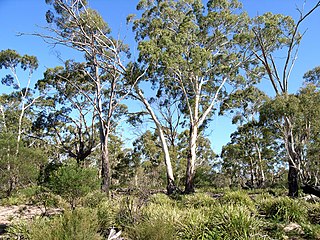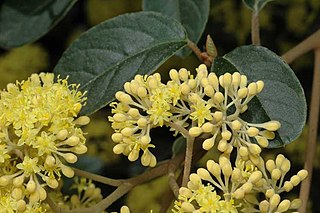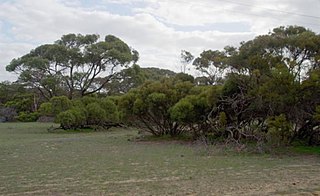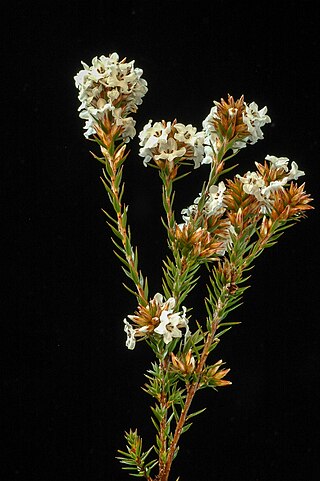
Eucalyptus viminalis, commonly known as the manna gum, white gum or ribbon gum, is a species of small to very tall tree that is endemic to south-eastern Australia. It has smooth bark, sometimes with rough bark near the base, lance-shaped to curved adult leaves, flower buds in groups of three or seven, white flowers and cup-shaped or hemispherical fruit.

Olearia argophylla, commonly known as musk daisy-bush, native musk or silver shrub, is a species of flowering plant in the family Asteraceae and is endemic to south-eastern Australia. It is a shrub or tree with silvery branchlets, egg-shaped to elliptic leaves, and white and yellow, daisy-like inflorescences.

Eucalyptus cordata, commonly known as the heart-leaved silver gum is a shrub to medium-sized tree that is endemic to Tasmania. It has smooth bark throughout, mostly only juvenile, more or less heart-shaped, glaucous leaves, glaucous flower buds arranged in groups of three, white flowers and cylindrical or hemispherical fruit.

Ozothamnus ferrugineus, commonly known as tree everlasting, is a member of the genus Ozothamnus, of the Asteraceae family – one of the largest families of flowering plants in Australia. Native to the Australian states of New South Wales, Victoria, South Australia, and Tasmania, it forms an erect shrub or small tree between 2 and 3 metres in height.

Olearia ramulosa, commonly known as twiggy daisy-bush, is a species of flowering plant in the family Asteraceae and is endemic to south-eastern Australia. It is a shrub with narrowly elliptic, linear or narrowly egg-shaped leaves, and pale blue, mauve or white and yellow, daisy-like inflorescences.

Persoonia juniperina, commonly known as prickly geebung, is a species of flowering plant in the family Proteaceae and is endemic to south-eastern Australia. It is a small erect to low-lying shrub with smooth bark, hairy new branches, linear leaves, yellow flowers borne singly or in groups of up to forty in leaf axils, and yellowish green to purplish fruit.

Stackhousia monogyna, commonly known as creamy stackhousia or creamy candles,is a flowering plant in the family Celastraceae. It is a small multi-stemmed plant with narrow leaves and terminal spikes of white, cream or yellow flowers. It is a widespread species found in all states of Australia but not the Northern Territory.

Conostylis aculeata, commonly known as prickly conostylis, is a flowering, tufted perennial plant in the family Haemodoraceae. It has flat leaves and yellow, hairy, tubular flowers. It is endemic to the south-west of Western Australia.

Pomaderris elliptica, commonly known as yellow dogwood or smooth pomaderris, is a species of flowering plant in the family Rhamnaceae and is endemic to south-eastern Australia. It is a shrub with densely hairy branchlets, egg-shaped or elliptic leaves, and pale yellow flowerss.

Pimelea ligustrina is a species of flowering plant in the family Thymelaeaceae, and is endemic to south-eastern Australia. It is a shrub with lance-shaped or narrowly elliptic leaves arranged in opposite pairs, and clusters of creamy-white, white or pinkish flowers usually surrounded by 4 or 8, greenish to reddish brown involucral bracts.

Olearia myrsinoides, commonly known as silky daisy-bush or blush daisy bush, is a species of flowering plant in the family Asteraceae and is endemic to south-eastern Australia. It is a spreading shrub with hairy branchlets, egg-shaped to elliptic leaves with toothed edges, and white and yellow or mauve, daisy-like inflorescences.

Cassinia laevis, commonly known as cough bush, dead finish, curry bush or rosemary bush, is a species of flowering plant in the family Asteraceae and is endemic to south-eastern continental Australia. It is a shrub with a curry-like odour, crowded linear leaves, and heads of creamy-white flowers arranged in panicles.
Cassinia decipiens is a species of flowering plant in the family Asteraceae and is endemic central New South Wales. It is a shrub with woolly-hairy young twigs, spreading, cylindrical leaves, and heads of creamy-brown to yellowish flowers arranged in a rounded cyme.

Cassinia macrocephala is a species of flowering plant in the family Asteraceae and is endemic to northern New South Wales. It is a shrub with narrow linear leaves and spherical, white to cream-coloured or yellowish-green heads.

Eucalyptus decipiens, commonly known as redheart or redheart moit is a species of mallee or small tree that is endemic to Western Australia. It has varying amounts of rough, imperfectly shed ribbons of brownish bark and smooth whitish to grey bark, lance-shaped adult leaves, flower buds in groups of between eleven and twenty one, and conical to flattened hemispherical fruit.

Epacris lanuginosa, commonly known as woolly-style heath, is a species of flowering plant in the family Ericaceae and is endemic to south-eastern Australia. It is a slender, erect shrub with hairy branchlets, linear to lance-shaped leaves, and tube-shaped, white flowers crowded along the ends of the branches.

Brachyscome aculeata, commonly known as hill daisy, is a tufted perennial herb in the family Asteraceae and is endemic to Australia. It has mostly white daisy-like flowers, a yellow centre, variable shaped leaves and flowers in spring to autumn.

Olearia glandulosa, commonly known as swamp daisy-bush, is a species of flowering plant in the family Asteraceae and is endemic to south-eastern Australia. It is a slender, erect, glabrous shrub with sticky, narrowly linear leaves and white or pale blue and yellow, daisy-like inflorescences.

Olearia stellulata is a species of flowering plant in the family Asteraceae and is endemic to south-eastern Australia. It is a shrub with lance-shaped or narrowly elliptic leaves, and white and yellow or mauve, daisy-like inflorescences.

Olearia teretifolia is a species of flowering plant in the family Asteraceae and is endemic to south-eastern Australia. It is a bushy shrub with lance-shaped, egg-shaped or elliptic leaves arranged in opposite pairs, and white and yellow, daisy-like inflorescences.



















